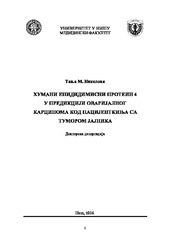Приказ основних података о дисертацији
Humani epididimisni protein 4 u predikciji ovarijalnog karcinoma kod pacijentkinja sa tumorom jajnika
| dc.contributor.advisor | Živadinović, Radomir | |
| dc.contributor.other | Popović, Jasmina | |
| dc.contributor.other | Stanojević, Zorica | |
| dc.contributor.other | Petić, Aleksandra | |
| dc.contributor.other | Folić, Miroslav | |
| dc.creator | Nikolova, Tanja M. | |
| dc.date.accessioned | 2016-12-30T15:41:23Z | |
| dc.date.available | 2016-12-30T15:41:23Z | |
| dc.date.available | 2020-07-03T16:07:57Z | |
| dc.date.issued | 2016-07-08 | |
| dc.identifier.uri | https://nardus.mpn.gov.rs/handle/123456789/7220 | |
| dc.identifier.uri | http://eteze.ni.ac.rs/application/showtheses?thesesId=4380 | |
| dc.identifier.uri | https://fedorani.ni.ac.rs/fedora/get/o:1193/bdef:Content/download | |
| dc.identifier.uri | http://vbs.rs/scripts/cobiss?command=DISPLAY&base=70052&RID=1025567725 | |
| dc.description.abstract | Background In the Unites States of America, near 10% of women in their lifetime will be hospitalized and operated on because of ovarian mass suspected for an ovarian cancer. Diagnostic options are limited for a gynecologist to detect ovarian cancer in its early stages. As a result, around 70% of ovarian cancer cases are diagnosed in the advanced disease stages, when 5-year survival is sometimes less than 30%. The prognosis is better, if the surgery is performed by gynecological oncologist in specialized cancer care centers. In that direction, a proper triage is of pivotal importance for an optimal surgical treatment and consequently a better survival. Objectives To find out the validity of tumor marker HE4 in diagnosis of ovarian cancer and compare it with the validities of CA125 and ultrasound. To find out the validity of our Algorithm for prediction of ovarian malignancy (APOM) and compare it with validities of biochemical tumor markers previously mentioned, algorithms, ultrasound scores and doppler indices (ROMA, CPH-I, RMI, MI, PI and RI). Material and methods Prospective clinical trial included 200 cases in the study group with detected ovarian tumor by ultrasound. Inclusion criteria were: women 18 years of age and older with an ovarian mass, scheduled for surgical intervention. Exclusion criteria: pregnant women, women during lactation, women with prior unilateral and/or bilateral oophorectomy, women with history of current or past malignancy and advanced chronic diseases. The control group represented by healthy women included 100 women with normal ultrasound scan of the ovaries. Ultrasonography was performed using GE Voluson Е8 ultrasound machine with a transvaginal ultrasound probe RIC5-9D, 4-9 MHz (ovarian tumor morphology and doppler of the tumor vasculature). Afterward, patients were scheduled for vein blood sampling for HE4 and CA125 determination. After the surgery and histology verification of the operative material, patients were grouped according to the finding in a group with malign ovarian tumor and a group with benign ovarian tumor. Results Out of 181 cases with ovarian tumor, 40 were diagnosed with epithelial ovarian cancer, 2 with stromal malign tumor, 6 “borderline”, and 133 with benign ovarian tumor. We have analyzed in total 79 healthy women. Validities of tumor markers HE4 and CA125 were calculated only for epithelial ovarian cancer cases and benign ovarian tumors. Sensitivity, Specificity, PPV, NPV and Accuracy for HE4: 75,00%; 87,69; 65,22; 91,94 and 84,71; respectively. For CA125: 80,80%; 59,23%; 37,65%; 90,59 and 64,12; respectively. For ROMA: 97,50%; 69,23%; 49,37%; 98,90 and 75,88. For CPH-I: 92,50%; 84,62%; 64,91% 97,35% and 86,47%. For RMI: 92,50%; 83,85%; 63,79%; 97,32% and 85,88%. For MI: 85,00%; 56,23%; 92,77% and 65,29%. For PI: 65,00%; 52,31%; 29,55%, 82,93% and 55,29%. For RI: 52,50%; 90,77%; 63,64; 86,13 and 81,76%. For APOM: 90,00%; 97,69%; 92,31%; 96,95% and 95,88%. ROC – AUC analyses for the tested parameters as follows: HE4 AUC = 0,946; CA125 AUC = 0,876; ROMA AUC = 0,957; CPH-I AUC = 0,956; RMI AUC = 0,934; MI AUC = 0,836; PI AUC = 0,717; RI AUC = 0,746; APOM AUC = 0,977. Conclusions On the whole population tested (both pre- and postmenopausal together), CA125 appeared to more sensitive than HE4, but, HE4 was far more specific. Of all tested parameters, ROMA was the most sensitive, and APOM was the most specific in the prediction of epithelial ovarian cancer in patients with ovarian tumor. | en |
| dc.format | application/pdf | |
| dc.language | sr | |
| dc.publisher | Универзитет у Нишу, Медицински факултет | sr |
| dc.rights | openAccess | en |
| dc.rights.uri | https://creativecommons.org/licenses/by-nc-nd/4.0/ | |
| dc.source | Универзитет у Нишу | sr |
| dc.subject | HE4 | sr |
| dc.subject | HE4 | en |
| dc.subject | CA125 | sr |
| dc.subject | ROMA | sr |
| dc.subject | CPH-I | sr |
| dc.subject | RMI | sr |
| dc.subject | MI | sr |
| dc.subject | dopler | sr |
| dc.subject | APOM | sr |
| dc.subject | ovarijalni karcinom | sr |
| dc.subject | predikcija | sr |
| dc.subject | CA125 | en |
| dc.subject | ROMA | en |
| dc.subject | CPH-I | en |
| dc.subject | RMI | en |
| dc.subject | MI | en |
| dc.subject | doppler | en |
| dc.subject | APOM | en |
| dc.subject | ovarian cancer | en |
| dc.subject | prediction | en |
| dc.title | Humani epididimisni protein 4 u predikciji ovarijalnog karcinoma kod pacijentkinja sa tumorom jajnika | sr |
| dc.type | doctoralThesis | en |
| dc.rights.license | BY-NC-ND | |
| dcterms.abstract | Живадиновић, Радомир; Станојевић, Зорица; Фолић, Мирослав; Поповић, Јасмина; Петић, Aлександра; Николова, Тања М.; Хумани епидидимисни протеин 4 у предикцији оваријалног карцинома код пацијенткиња са тумором јајника; Хумани епидидимисни протеин 4 у предикцији оваријалног карцинома код пацијенткиња са тумором јајника; | |
| dc.identifier.fulltext | https://nardus.mpn.gov.rs/bitstream/id/53403/Disertacija7251.pdf | |
| dc.identifier.fulltext | http://nardus.mpn.gov.rs/bitstream/id/53403/Disertacija7251.pdf | |
| dc.identifier.rcub | https://hdl.handle.net/21.15107/rcub_nardus_7220 |


